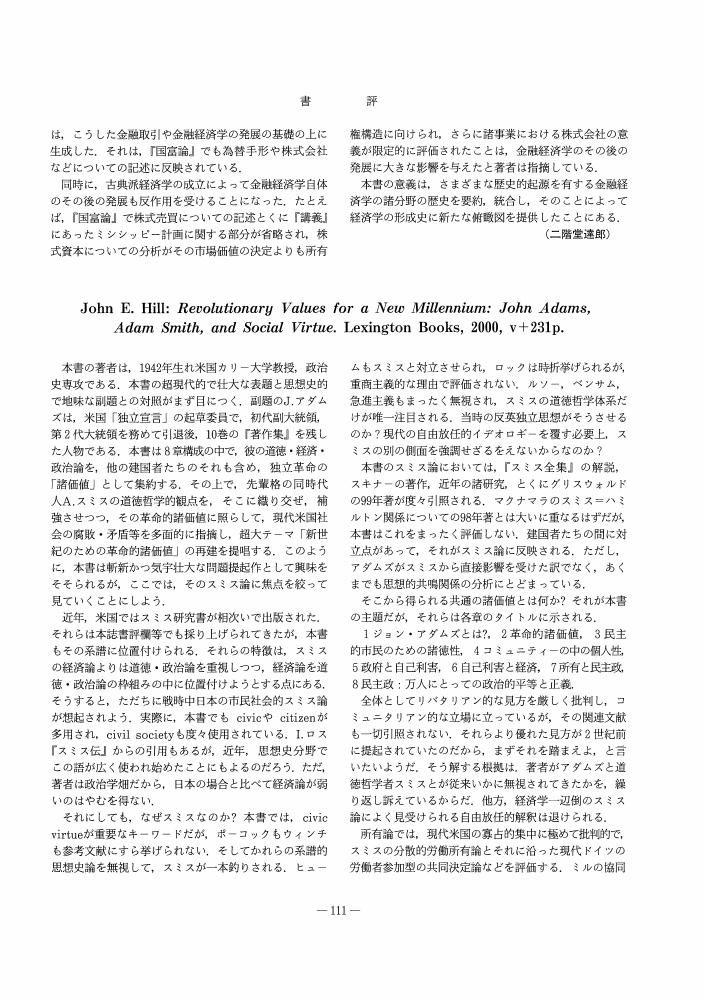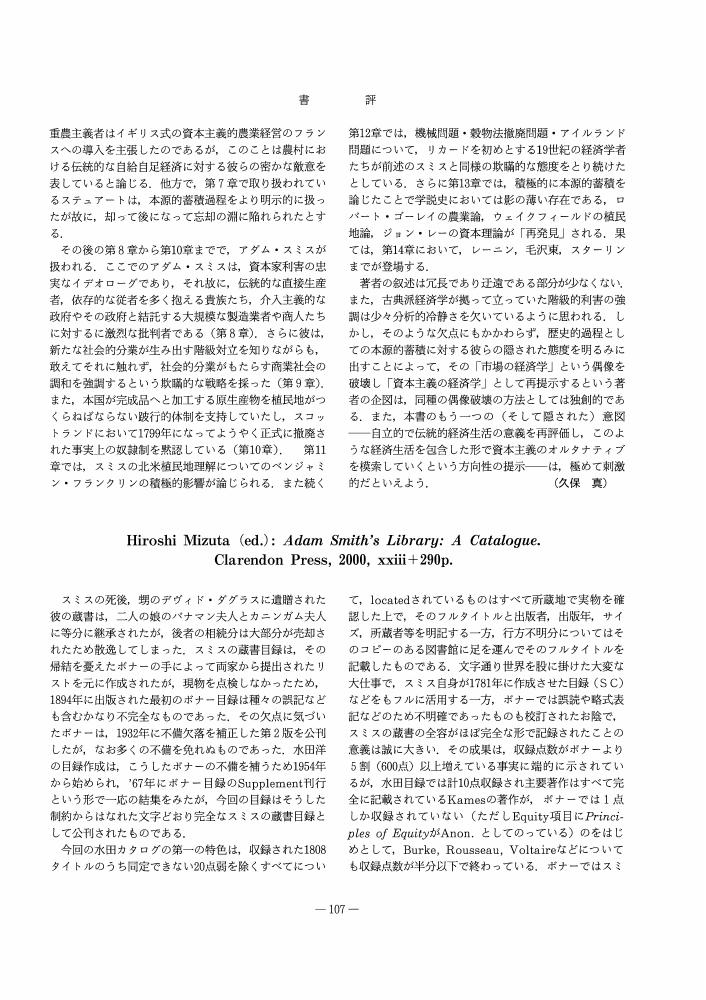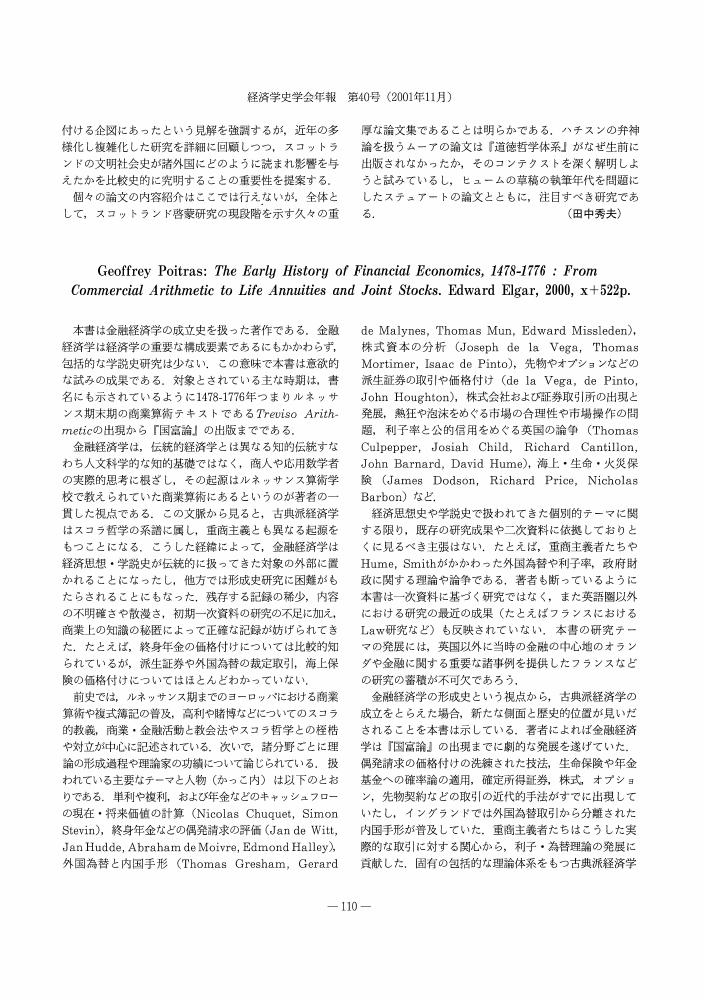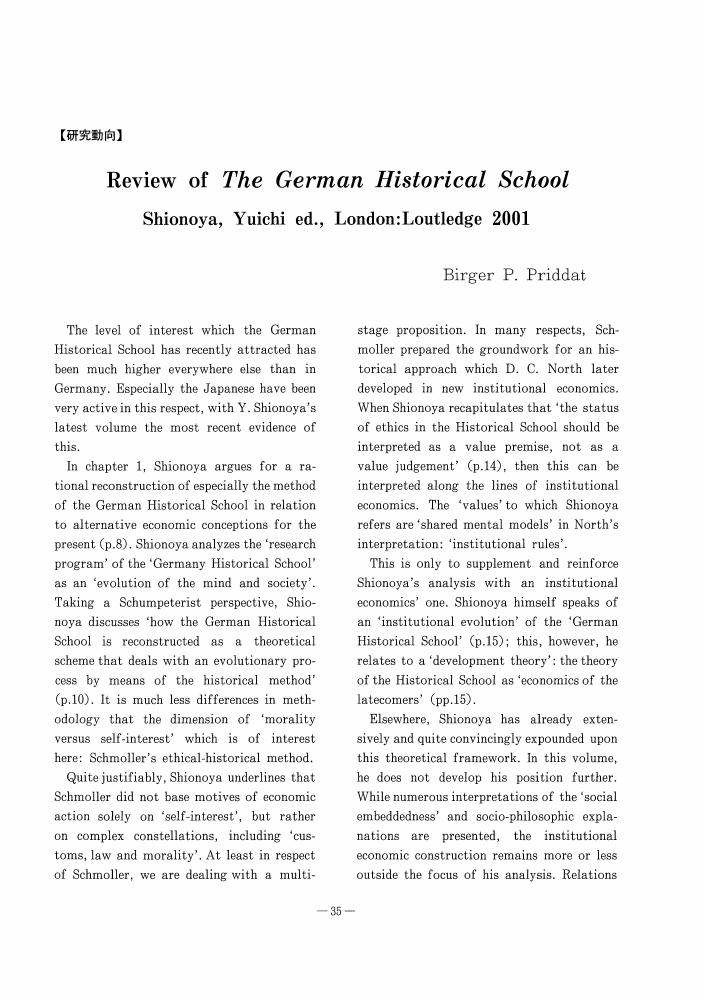- 著者
- 佐々木 政憲
- 出版者
- The Japanese Society for the History of Economic Thought
- 雑誌
- 経済学史学会年報 (ISSN:04534786)
- 巻号頁・発行日
- vol.41, no.41, pp.112-113, 2002 (Released:2010-08-05)
1 0 0 0 OA Eric Keslassy: Le Liberalisme de Tocqueville: à l'épreuve du paupérisme. L'Harmattan, 2000, 285 pp.
- 著者
- 稲井 誠
- 出版者
- The Japanese Society for the History of Economic Thought
- 雑誌
- 経済学史学会年報 (ISSN:04534786)
- 巻号頁・発行日
- vol.41, no.41, pp.113-114, 2002 (Released:2010-08-05)
- 著者
- Warren J. Samuels
- 出版者
- The Japanese Society for the History of Economic Thought
- 雑誌
- 経済学史学会年報 (ISSN:04534786)
- 巻号頁・発行日
- vol.41, no.41, pp.115-116, 2002 (Released:2010-08-05)
- 参考文献数
- 1
1 0 0 0 OA 古典派の経済人概念
- 著者
- 佐々木 憲介
- 出版者
- The Japanese Society for the History of Economic Thought
- 雑誌
- 経済学史学会年報 (ISSN:04534786)
- 巻号頁・発行日
- vol.41, no.41, pp.71-79, 2002 (Released:2010-08-05)
- 参考文献数
- 49
It is probably W. Bagehot who coined the term ‘economic man’. As is commonly acknowledged, however, ‘economic man’ played a substantial role in classical political economy long before the term was coined. This survey examines the literature treating the classical economic man from three aspects: motives and rationality, historical characteristics, and epistemological foundations. (1) The classical economic man was characterized by several motives and rationality. The motives included self-interest and the desire for wealth. Rationality indicated that economic man attempted to obtain additional wealth with as little sacrifice as possible. The motives, however, were deleted from the concept of neo-classical economic man set out in the 1930s, and rationality came to be considered as the essence of the notion. (2) Interpretations on the historical characteristics of economic man differ. Some regard the classical economic man as a real agent who appeared in a particular area and period. Others insist that the economic man is an abstract or hypothetical man, the features of which indicates a universal tendency applicable to all economic situations, although the realization of tendency is more or less interfered with by disturbing forces. The relations between society and the individual are another issue. The economic man is said to be based on methodological individualism, but the classical concept does not ignore the influence of society upon individual. (3) Classical methodologists such as N. W. Senior, J. S. Mill, and J. E. Cairns thought that the motives and rationality of economic man could be clarified through the processes of reflection and analogy. Senior, however, realized a defect in this method. Adam Smith suggested an interesting method by which to test the results of reflection and analogy. If the concept of economic man is accepted, it can be considered to stand as a true assumption of economic action.
- 著者
- 星野 彰男
- 出版者
- The Japanese Society for the History of Economic Thought
- 雑誌
- 経済学史学会年報 (ISSN:04534786)
- 巻号頁・発行日
- vol.40, no.40, pp.111-112, 2001 (Released:2010-08-05)
- 著者
- 的場 昭弘
- 出版者
- The Japanese Society for the History of Economic Thought
- 雑誌
- 経済学史学会年報 (ISSN:04534786)
- 巻号頁・発行日
- vol.40, no.40, pp.112-113, 2001 (Released:2010-08-05)
- 著者
- A. M. C. Waterman
- 出版者
- The Japanese Society for the History of Economic Thought
- 雑誌
- 経済学史学会年報 (ISSN:04534786)
- 巻号頁・発行日
- vol.41, no.41, pp.1-14, 2002 (Released:2010-08-05)
- 参考文献数
- 43
- 著者
- Takashi Nishimura
- 出版者
- The Japanese Society for the History of Economic Thought
- 雑誌
- 経済学史学会年報 (ISSN:04534786)
- 巻号頁・発行日
- vol.41, no.41, pp.15-24, 2002 (Released:2010-08-05)
- 参考文献数
- 22
- 著者
- Mitsunobu Maki
- 出版者
- The Japanese Society for the History of Economic Thought
- 雑誌
- 経済学史学会年報 (ISSN:04534786)
- 巻号頁・発行日
- vol.41, no.41, pp.25-34, 2002 (Released:2010-08-05)
- 参考文献数
- 42
1 0 0 0 OA 理想的功利主義者としてのピグー
- 著者
- 山崎 聡
- 出版者
- The Japanese Society for the History of Economic Thought
- 雑誌
- 経済学史学会年報 (ISSN:04534786)
- 巻号頁・発行日
- vol.41, no.41, pp.35-47, 2002 (Released:2010-08-05)
- 参考文献数
- 32
This paper is intended as an investigation of A. C. Pigou's ethics. Thus far, few attempts have been made to investigate his philosophical (ethical) side. The point I want to make is that, contrary to the ordinary interpretation, Pigou's ethical idea does not belong to the traditional hedonistic utilitarian view espoused by Bentham, J. S. Mill, and Sidgwick, but to the ideal (i. e., non-hedonistic) utilitarian view originated by G. E. Moore.First, it is notable that Pigou, following Moore, recognizes that “good” is indefinable; he clearly makes a distinction between “What is good?” and “What is the good?” Pigou's response to the latter is as follows.In the hedonistic utilitarian view, the only intrinsically good thing is “pleasure.” Pigou, in his early article (1907), completely disagrees with this thesis. He asserts that pleasure is not the sole good, and that there are plural elements (i. e., not only pleasure but also love, good will, and so on) which are intrinsic goods; they compose a state of conscious life. A state of conscious life, Pigou says, is a complex of many factors such as those remarked above. In describing how a state of conscious life as a complex whole does have intrinsic value, Pigou relates that the goodness of conscious states is, to use a mathematical phrase, a function of several variables, some of which can be specified (i. e., pleasure, love, good will); the dependent variable represents the intrinsic value of the complex whole.In a later article (1932), Pigou discusses a problem quite different from that laid out above: what sort of actions ought to be performed? This is, to put it briefly, a problem of the relation between good and right. In short, Pigou defines right as “the cause of a good result”, which is thus identical with “useful”; he positively affirms that the end (i. e., the intrinsic good) always will justify the means, and any action that is not justified by its consequences can not be right. This is a typical teleological view.It follows from what has been said above that Pigou and Moore make use of the same ethical reasoning when answering two questions: “What is the good?” and “What kind of action ought to be performed?” That is to say, Pigou, as well as Moore, adopts teleology (consequentialism), plurality in the theory of value, and commensurability of plural goods. Further, the commensurability is based on the intuitive idea of good, and then this is a kind of idealism. On these grounds, I have come to the conclusion that Pigou is the ideal utilitarian.
1 0 0 0 OA 合理的期待形成と再帰性
- 著者
- 金子 裕一郎
- 出版者
- The Japanese Society for the History of Economic Thought
- 雑誌
- 経済学史学会年報 (ISSN:04534786)
- 巻号頁・発行日
- vol.41, no.41, pp.48-57, 2002 (Released:2010-08-05)
- 参考文献数
- 13
This paper deals with three issues which will be considered in terms of waiting, developed as liquidity preference function problems after J. M. Keynes. Firstly, expectation is halved with time expectation in reflective expectation by reinterpretation of Lucas critique, and uncertainty of the reflective expectation formation is considered. Secondly, as an applied example of reflective expectation, it is considered why Keynes used a term of marginal efficiency of capital rather than marginal efficiency of investment. Thirdly, it is shown that the rational expectation formation would not contain expectation formation with waiting in Keynes' meaning.The argument is as follows. In section I, the problem of waiting is discussed as one of expectation formation. Then, our concept of waiting is defined as an expansion of it used in Keynes' General Theory, referring to Hicks' interpretation of liquidity preference function. In section II, Lucas critique is compared with Keynes' famous metaphor of a beauty contest, in order to examine the relationship between waiting and reflective expectation. The basis of the reflective expectation formation is pursued by using Lucas critique. In the traditional interpretation of Keynes, reflective expectation has been thought of in light of the metaphor of a beauty contest only in money market. However, reflective expectation also works in commodity market. While some regarded these problems as self-evident, others failed to deal with appropriately. It explains how they failed to recognize them as problem of action theory and how relevant theories remained to be lacking in their micro-foundation. The metaphor of a beauty contest and the differences between its implications and Lucas critique are also examined. In section III, it is explained that the marginal efficiency of capital plays a different role from marginal efficiency of investment by taking account of reflective expectation.Hence, it will be concluded that waiting could be conceptualized in a way that supports the marginal efficiency of capital as well as liquidity preference function, and that its concept deviates from the rational expectation formation.
1 0 0 0 OA ハロッド動学のアンティノミー理論はなぜ失われたのか?
- 著者
- 中村 隆之
- 出版者
- The Japanese Society for the History of Economic Thought
- 雑誌
- 経済学史学会年報 (ISSN:04534786)
- 巻号頁・発行日
- vol.41, no.41, pp.58-70, 2002 (Released:2010-08-05)
- 参考文献数
- 45
Harrod's Dynamics represented a methodological revolution because his trade cycle theory not only connects multiplier and relation (acceleration) with each other, but also rejects the explanation of trade cycle by sequence of temporary equilibrium. Harrod showed the originality of his dynamics as the difference between lag theory of Samuelson, Hicks, Tinbergen etc. and antinomy theory of his own. But few number of economist understood the essence of his antinomy theory.Baumol, Alexander and many others regarded Harrod's theory as imperfect because his fundamental equation is merely identical equation, therefore it does not determine the behavior of the next moment. They thought the behavioral equation must be added in order to complete Harrod's model.Shackle insisted Harrod's ‘one point in time’ approach excluded the essential uncertainty in decision-making. Okishio insisted that difference-differential equation is essential for the completion of Harrod's instability principle. Although Besomi, scholar of Harrod's economics, introduces the Harrod's methodology, he also regards the fundamental equation in Harrod's Essay as missing the consideration of expectations.All critics above did not understand that his dynamics represents a direction of the movement at the very moment in time and need not have a behavioral equation. Harrod thought the moment analysis is more important than locus in the time sequence. But they held that the opposite of his intention was true.Despite these critiques I insist that Harrod's antinomy theory is valid and his methodology is very useful. For my conclusion I criticize Okishio model, which is representative interpretation of Harrod's instability principle so far. The model has two behavioral equations for product-decision and investment-decision.Harrod's fundamental equation expresses the antinomy of economic structure, which always exists, by the form of identical equation. Identical equation is objective, valid for qualitative analysis. His objective approach is similar to Keynes's approach which uses the fundamental equation in A Treatise on Money and the instantaneous multiplier in General Theory.Harrod's antinomy theory has been lost because the objective approach to dynamics was not understood. It is to emphasize that the ultimate cause of misunderstandings is a strong leaning toward the micro foundation of modern economics. We incline to start with individually subjective decision-making, not objective structure.
- 著者
- 大倉 正雄
- 出版者
- The Japanese Society for the History of Economic Thought
- 雑誌
- 経済学史学会年報 (ISSN:04534786)
- 巻号頁・発行日
- vol.40, no.40, pp.104-105, 2001 (Released:2010-08-05)
1 0 0 0 OA John B. Foster: Marx's Ecology: Materialism and Nature. Monthly Review Press, 2000, x+310p.
- 著者
- 工藤 秀明
- 出版者
- The Japanese Society for the History of Economic Thought
- 雑誌
- 経済学史学会年報 (ISSN:04534786)
- 巻号頁・発行日
- vol.40, no.40, pp.105-106, 2001 (Released:2010-08-05)
- 著者
- 久保 真
- 出版者
- The Japanese Society for the History of Economic Thought
- 雑誌
- 経済学史学会年報 (ISSN:04534786)
- 巻号頁・発行日
- vol.40, no.40, pp.106-107, 2001 (Released:2010-08-05)
1 0 0 0 OA Hiroshi Mizuta (ed.): Adam Smith's Library: A Catalogue. Clarendon Press, 2000, xxiii+290p.
- 著者
- 田中 正司
- 出版者
- The Japanese Society for the History of Economic Thought
- 雑誌
- 経済学史学会年報 (ISSN:04534786)
- 巻号頁・発行日
- vol.40, no.40, pp.107-109, 2001 (Released:2010-08-05)
- 著者
- 田中 秀夫
- 出版者
- The Japanese Society for the History of Economic Thought
- 雑誌
- 経済学史学会年報 (ISSN:04534786)
- 巻号頁・発行日
- vol.40, no.40, pp.109-110, 2001 (Released:2010-08-05)
- 著者
- 二階堂 達郎
- 出版者
- The Japanese Society for the History of Economic Thought
- 雑誌
- 経済学史学会年報 (ISSN:04534786)
- 巻号頁・発行日
- vol.40, no.40, pp.110-111, 2001 (Released:2010-08-05)
- 著者
- Birger P. Priddat
- 出版者
- The Japanese Society for the History of Economic Thought
- 雑誌
- 経済学史学会年報 (ISSN:04534786)
- 巻号頁・発行日
- vol.40, no.40, pp.35-42, 2001 (Released:2010-08-05)
1 0 0 0 OA フランク・ナイトにおける企業者と競争的経済秩序
- 著者
- 黒木 亮
- 出版者
- The Japanese Society for the History of Economic Thought
- 雑誌
- 経済学史学会年報 (ISSN:04534786)
- 巻号頁・発行日
- vol.40, no.40, pp.43-55, 2001 (Released:2010-08-05)
- 参考文献数
- 50
The thrust of this paper is to ascertain the theoretical base of Knight's critical writings in social science, and to search out fundamentals of his pluralistic thought, by reconstructing his theory of profit in Risk.The point of Risk is comprised in three statements: (1) Suggestions by advocates of laissez-faire policy on the market price theory require the implicit assumption of perfect knowledge; (2) Estimates made by those who have only imperfect knowledge produce some significant effects on a real and uncertain world; (3) Profits accrue to the entrepreneur who makes the responsible estimate from its margin of error, real uncertainty.The intention of Knight in developing his theory was to placard the unrealities of postulates of theoretical economics for the purpose of making clear the limitations of economics, and for establishing its dignity as an exact science. He therefore proceeded to insist on the necessity of rapprochement between economics and the other social sciences, especially ethics, in order to debate the desirable social order or social betterment.Thus, Risk not only formed the solid ground of Knight's methodological discussion about social philosophy, but also laid the foundation of modern American economics.














